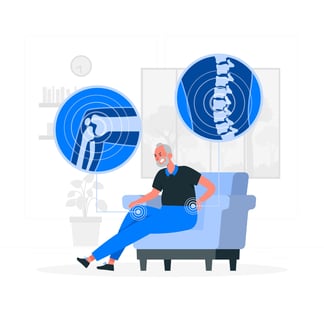Maintaining Bone Density After a Spinal Cord Injury
There are a lot of ways the body changes after a spinal cord injury and bone density is one of the most important things to keep an eye on since bone fractures can be incredibly frustrating and challenging to heal. After 2-3 years post-injury, many people lose significant amounts of bone density due to no longer walking. The lack of weight-bearing impacts the bone, meaning bone doesn't build the same. Bone density loss can be dangerous, but the good news is that it can be helped.
Below you'll find the most popular and widely accepted medical interventions for improving bone density after a spinal cord injury. There has been a lot of miscommunication among medical professionals over the years in regard to what are the best prevention methods. We hope the methods listed below help put you on the right path for maintaining bone density long-term.
DXA Scan
For many people with spinal cord injuries, their doctors will order a DXA scan, which is medical imaging that uses very low levels of X-rays to measure bone density. This is an important test since it can reveal osteoporosis levels and fracture risks. There are many people however that complain about the validity of DXA scans because the results can often vary. A DXA scan is typically recommended every 2 to 3 years for people with spinal cord injuries, and if bone density loss is detected, doctors will typically prescribe some kind of infusion or supplement to help slow down/prevent bone loss.
REMs Scan
A similar bone density test but using newer technology is a REMs scan. This scan looks at bone density and can help doctors give people with spinal cord injuries a diagnosis for osteoporosis, as well as a fracture risk assessment. For many people, they prefer this scan versus a DXA scan since it doesn't use any radiation. Instead, it uses radio frequency echographic multi-spectrometry scanning to get a closer look at bone density.
Vitamin D3/Calcium Supplements
Both vitamin D3 and calcium supplements are highly recommended by doctors as an effective method for preventing bone density loss, and also for helping build it back. There are a lot of different supplements available for this vitamin/mineral combo and many people recommend Adcal-D3, an oral supplement that contains both calcium and vitamin D3. Vitamin D3 is sometimes considered the safer of these two since calcium supplements can "feed" heterotopic ossification, ie, make it worse.
Calcium/Iron Infusions
Many people are prescribed calcium and iron infusions after getting their bones scanned and after trying other calcium/iron oral supplements to no avail. One of the most popular calcium injections is Denosumab, also known as Prolia. This treatment has been known to help people who did not respond to other medication treatments for osteoporosis.
K2 Supplements
Vitamin K2 used to be a vitamin that was consumed regularly by Americans in vegetables like brussel sprouts and in various fermented foods however nowadays many people are not getting enough vitamin K2, which can lead to weaker bones. In Japan, vitamin K2 is found in natto, a fermented soybean product, and is consumed regularly by most people. When taking vitamin K2, it has an "anabolic" effect on the bones meaning it can promote bone marrow stem cell growth, as well as stimulate other various bone cells. It also has the ability to help calcium go directly to the bones, rather than elsewhere in the body.
Doctors recommend taking either a vitamin K2 supplement or trying to get more vitamin K2 through one’s diet by eating products from grass-fed animals such as butter, meats, dairy products, and egg yolks.
Eat Vitamin D & Calcium Enriched Foods
Probably one of the easiest ways to improve bone health after a spinal cord injury is to eat foods that are high in vitamin D and calcium. One of the best foods you can eat that has both vitamin D and calcium are dark leafy greens like kale, spinach, and collard greens. For food that has high amounts of vitamin D, reach for fattier fish like salmon, herring, tuna, and sardines, as well as egg yolks and mushrooms, all of which have high amounts of vitamin D. And for food with significant amounts of calcium, reach for broccoli and dairy products like cheese, yogurt or milk.
Vibration Plate with Standing Frame
For years, many people after their spinal cord injury were told that standing in a standing frame or in a standing wheelchair on a daily basis could prevent bone density loss. However recently, it was revealed that standing alone is not enough and that walking is needed. Unfortunately, since this is impossible for most people with paralysis, utilizing a vibration plate is now popular among people with SCIs. When standing in a standing frame, a vibration plate is put underneath the feet which helps simulate what walking does to the bones.
FES
A popular weight-bearing exercise to also try is functional electronic stimulation, also known as FES. Most people will utilize FES for cycling, which can be a great way to boost bone density if done on a regular basis. FES cycles are available for purchase for home use and in many cities across the country, outpatient spinal cord injury rehabilitation facilities offer free use of their FES cycles to patients.

Alendronic Acid
For many people, after getting either a DXA scan or a REMs scan and receiving an osteoporosis diagnosis, their doctor will prescribe them an ongoing treatment of alendronic acid. Alendronic acid cannot cure osteoporosis, but it can control osteoporosis, meaning it will not get any worse as long as you continue taking it. It has the ability to increase the amount of calcium in your bones, making your bones stronger and less likely to break as long as you take the medication.
Exercise the Upper Body
Although it may sound strange, exercising your upper body can have a serious impact on bones throughout your body, increasing bone density in all of them, not just your arms. This is why it is critical to exercise your upper body on a regular basis, typically at least 3 to 4 times a week. Arm weights, stationary handcycles, handcycling in general, swimming, and HIIT workouts are some of the many ways to work out your upper body with a spinal cord injury.
Stay Updated on Advancements On Traumatic Brain &
Spinal Cord Injuries
About the Author





